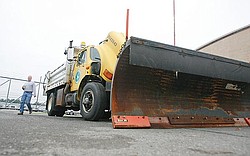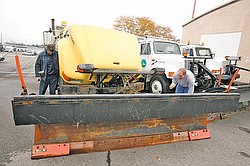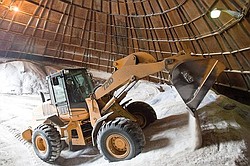Is ODOT ready for winter?
ODOT workers Matt Kotanchek checks over one of the plow/slag trucks at the ODOT garage in Canfield.
ODOT workers Matt Kotanchek and John Keeney check over one of the plow/slag trucks at the ODOT garage in Canfield.
Boardman Township Road Department piles salt inside a silo the township maintains off Market Street.
District 4 ranks second in the state for snowfall.
By DENISE DICK and D.A. WILKINSON
VINDICATOR STAFF WRITERS
The weather outside isn’t yet frightful, but Ohio Department of Transportation trucks and drivers are ready for when it turns.
ODOT District 4, which encompasses Mahoning, Trumbull, Ashtabula, Portage, Summit and Stark counties, has been inspecting, testing and preparing equipment to ensure vehicles are road-ready.
Justin Chesnic, District 4 spokesman, said the district has ample salt ready for the season with contracts to restock if supplies run low.
“About three years ago, [salt] was about $30 to $40 per ton,” Chesnic said. “Then it went up to $60 or even as high as $100 per ton. This year, it’s about $50 to $60 per ton, so it’s down — but it’s still not what it was three years ago.”
The six-county district ranks second in the state in terms of snowfall with an average of 81 inches per season. First is District 12, which includes Cuyahoga, Geauga and Lake counties.
District 4 used 1.5 million gallons of salt brine and 99,300 tons of salt during the 2008-09 season to maintain its 10,127 lane miles.
District 12, by comparison, used 196,187 gallons of salt brine and 71,291 tons of salt last season to maintain its 6,278 lane miles. Salt brine is used to pretreat roads before snow or ice fall as well as to de-ice.
Dealing with Mother Nature in winter is not a matter of the amount of resources but of using the resources where they will do the most good, according to Becky McCarty, a spokesperson for ODOT District 11, which includes Columbiana County.
“Even though there is not a salt shortage, we still have to be fiscally responsible,” she added.
Jim Graham, an operations manager for District 11, said shortages of road salt in recent years were caused by big storms, over-purchasing and the ability of the underground mines to produce only a certain amount of salt.
“Freezing rain chews up salt like you can’t believe,” he said.
Trying to apply salt at 5 degrees at night versus 30 degrees during the day uses 11 times as much gas, he said. That’s why crews may be out during the day instead of the middle of the night.
ODOT officials are using the slogan “the right plan, the right mix, and the right time.”
One snowplow truck can make a 30-mile trip at 35 miles per hour before it has to return to the ODOT garage on U.S. Route 30 west of Lisbon.
Reloading the truck and getting back on the road can take up to two hours.
Taking steps to get ready is not only applicable to ODOT but to the motorists.
“The most important thing is to slow down — give yourself more distance,” said Lt. Christopher M. Heverly, commander of the Ohio State Highway Patrol’s Canfield Post.
Keep a distance between yourself and a snowplow, too, Heverly urges.
“If you can, stay behind them,” Chesnic said of snowplows.
The snowplow driver is treating the road, so staying behind the plow provides a safer surface for travel. If a motorist passes a plow, they may be driving on untreated surface, he said.
District 4 maintains 152 vehicles to combat the winter road conditions including plows, multipurpose vehicles, tankers and trucks to plow, salt and pretreat roads. That includes 20 vehicles in Mahoning County and 31 in Trumbull.
“Our drivers are second to none as far as we’re concerned,” Chesnic said.
They complete snow and ice school with annual refresher sessions.
The trucks feature equipment to allow the driver to calibrate the amount of salt used depending on the conditions.
“If there’s just a little bit of snow, the driver can trickle the salt,” Chesnic said. “If there’s a lot of snow or a storm moving through, the driver can use more.”
Equipment inside the vehicles also allows a driver to monitor both the pavement and outdoor temperatures to determine whether salt or a salt/calcium-chloride mix is the most appropriate treatment route, Chesnic said.
A calcium-chloride mix is used when temperatures dip into the teens and low 20s.
 43
43



